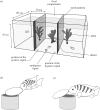Pair-bonding influences affective state in a monogamous fish species
- PMID: 31185864
- PMCID: PMC6571461
- DOI: 10.1098/rspb.2019.0760
Pair-bonding influences affective state in a monogamous fish species
Abstract
In humans, affective states are a key component in pair-bonding, particularly in the early stage of a relationship. Pairing with a high-quality partner elicits positive affective states which, in turn, validate and reinforce the mate choice. Affective states thus strongly affect pair stability and future reproductive success. We propose generalizing the link between affective states and pair-bonding to encompass other monogamous species exhibiting biparental care, chiefly where the reproductive success of the pair critically depends on the coordination between partners. The convict cichlid Amatitlania siquia is a monogamous fish species that forms long-lasting pairs with strong cooperation between parents for parental care. In this species, we showed that females paired with their non-preferred male had lower reproductive success than those paired with their preferred male. We then transposed the judgement bias paradigm, previously used in other animal species, to assess objectively affective states in fishes. Females that were assigned their non-preferred partner exhibited pessimistic bias, which indicates a negative affective state. By contrast, females that were assigned their preferred partner did not exhibit changes in their affective state. Our results highlight that the influence of pair-bonding on affective states is not human-specific and can also be observed in non-human species.
Keywords: convict cichlid Amatitlania siquia; emotion; judgement bias test; mate choice; optimistic–pessimistic bias; partner attachment.
Conflict of interest statement
We declare we have no competing interests.
Figures


Similar articles
-
Hormonal and fitness consequences of behavioral assortative mating in the convict cichlid (Amatitlania siquia).Gen Comp Endocrinol. 2017 Jan 1;240:153-161. doi: 10.1016/j.ygcen.2016.10.010. Epub 2016 Oct 25. Gen Comp Endocrinol. 2017. PMID: 27793721
-
Prosocial and antisocial choices in a monogamous cichlid with biparental care.Nat Commun. 2021 Mar 19;12(1):1775. doi: 10.1038/s41467-021-22075-6. Nat Commun. 2021. PMID: 33741978 Free PMC article.
-
Disruption in cortisol synchrony and pair-dissolution in the serially monogamous convict cichlid (Amatitlania nigrofasciata).Gen Comp Endocrinol. 2024 Oct 1;357:114589. doi: 10.1016/j.ygcen.2024.114589. Epub 2024 Jul 17. Gen Comp Endocrinol. 2024. PMID: 39025240 Review.
-
Neuropeptide regulation of social behavior in a monogamous cichlid fish.Physiol Behav. 2011 Mar 1;102(3-4):296-303. doi: 10.1016/j.physbeh.2010.11.022. Epub 2010 Nov 26. Physiol Behav. 2011. PMID: 21112347
-
Monogamy in marine fishes.Biol Rev Camb Philos Soc. 2004 May;79(2):351-75. doi: 10.1017/s1464793103006304. Biol Rev Camb Philos Soc. 2004. PMID: 15191228 Review.
Cited by
-
Optimism and pessimism: a concept for behavioural ecology.Biol Rev Camb Philos Soc. 2025 Jun;100(3):1152-1162. doi: 10.1111/brv.13178. Epub 2024 Dec 23. Biol Rev Camb Philos Soc. 2025. PMID: 39711313 Free PMC article. Review.
-
Trait sensitivity to stress and cognitive bias processes in fish: A brief overview.Personal Neurosci. 2024 Jan 31;7:e3. doi: 10.1017/pen.2023.14. eCollection 2024. Personal Neurosci. 2024. PMID: 38384666 Free PMC article. Review.
-
Optimistic and pessimistic cognitive judgement bias modulates the stress response and cancer progression in zebrafish.Transl Psychiatry. 2025 Mar 30;15(1):111. doi: 10.1038/s41398-025-03311-9. Transl Psychiatry. 2025. PMID: 40157919 Free PMC article.
-
Aggressive encounters lead to negative affective state in fish.PLoS One. 2020 Apr 14;15(4):e0231330. doi: 10.1371/journal.pone.0231330. eCollection 2020. PLoS One. 2020. PMID: 32287305 Free PMC article.
-
Improving welfare assessment in aquaculture.Front Vet Sci. 2023 Feb 28;10:1060720. doi: 10.3389/fvets.2023.1060720. eCollection 2023. Front Vet Sci. 2023. PMID: 36925609 Free PMC article.
References
-
- Mendl M, Burman OHP, Parker RMA, Paul ES. 2009. Cognitive bias as an indicator of animal emotion and welfare: emerging evidence and underlying mechanisms. Appl. Anim. Behav. Sci. 118, 161–181. (10.1016/j.applanim.2009.02.023) - DOI
Publication types
MeSH terms
Associated data
LinkOut - more resources
Full Text Sources
Other Literature Sources

